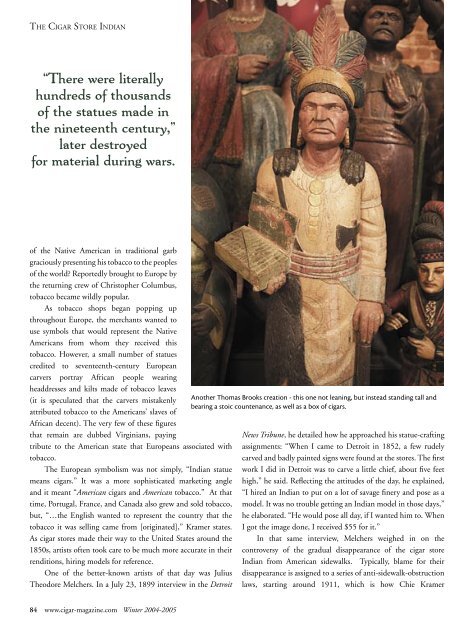The Cigar Store Indian - Evan Schuman
The Cigar Store Indian - Evan Schuman
The Cigar Store Indian - Evan Schuman
Create successful ePaper yourself
Turn your PDF publications into a flip-book with our unique Google optimized e-Paper software.
THE CIGAR STORE INDIAN<br />
“<strong>The</strong>re were literally<br />
hundreds of thousands<br />
of the statues made in<br />
the nineteenth century,”<br />
later destroyed<br />
for material during wars.<br />
of the Native American in traditional garb<br />
graciously presenting his tobacco to the peoples<br />
of the world? Reportedly brought to Europe by<br />
the returning crew of Christopher Columbus,<br />
tobacco became wildly popular.<br />
As tobacco shops began popping up<br />
throughout Europe, the merchants wanted to<br />
use symbols that would represent the Native<br />
Americans from whom they received this<br />
tobacco. However, a small number of statues<br />
credited to seventeenth-century European<br />
carvers portray African people wearing<br />
headdresses and kilts made of tobacco leaves<br />
(it is speculated that the carvers mistakenly<br />
attributed tobacco to the Americans’ slaves of<br />
African decent). <strong>The</strong> very few of these figures<br />
that remain are dubbed Virginians, paying<br />
tribute to the American state that Europeans associated with<br />
tobacco.<br />
<strong>The</strong> European symbolism was not simply, “<strong>Indian</strong> statue<br />
means cigars.” It was a more sophisticated marketing angle<br />
and it meant “American cigars and American tobacco.” At that<br />
time, Portugal, France, and Canada also grew and sold tobacco,<br />
but, “…the English wanted to represent the country that the<br />
tobacco it was selling came from [originated],” Kramer states.<br />
As cigar stores made their way to the United States around the<br />
1850s, artists often took care to be much more accurate in their<br />
renditions, hiring models for reference.<br />
One of the better-known artists of that day was Julius<br />
<strong>The</strong>odore Melchers. In a July 23, 1899 interview in the Detroit<br />
84 www.cigar-magazine.com Winter 2004-2005<br />
Another Thomas Brooks creation - this one not leaning, but instead standing tall and<br />
bearing a stoic countenance, as well as a box of cigars.<br />
News Tribune, he detailed how he approached his statue-crafting<br />
assignments: “When I came to Detroit in 1852, a few rudely<br />
carved and badly painted signs were found at the stores. <strong>The</strong> first<br />
work I did in Detroit was to carve a little chief, about five feet<br />
high,” he said. Reflecting the attitudes of the day, he explained,<br />
“I hired an <strong>Indian</strong> to put on a lot of savage finery and pose as a<br />
model. It was no trouble getting an <strong>Indian</strong> model in those days,”<br />
he elaborated. “He would pose all day, if I wanted him to. When<br />
I got the image done, I received $55 for it.”<br />
In that same interview, Melchers weighed in on the<br />
controversy of the gradual disappearance of the cigar store<br />
<strong>Indian</strong> from American sidewalks. Typically, blame for their<br />
disappearance is assigned to a series of anti-sidewalk-obstruction<br />
laws, starting around 1911, which is how Chie Kramer


